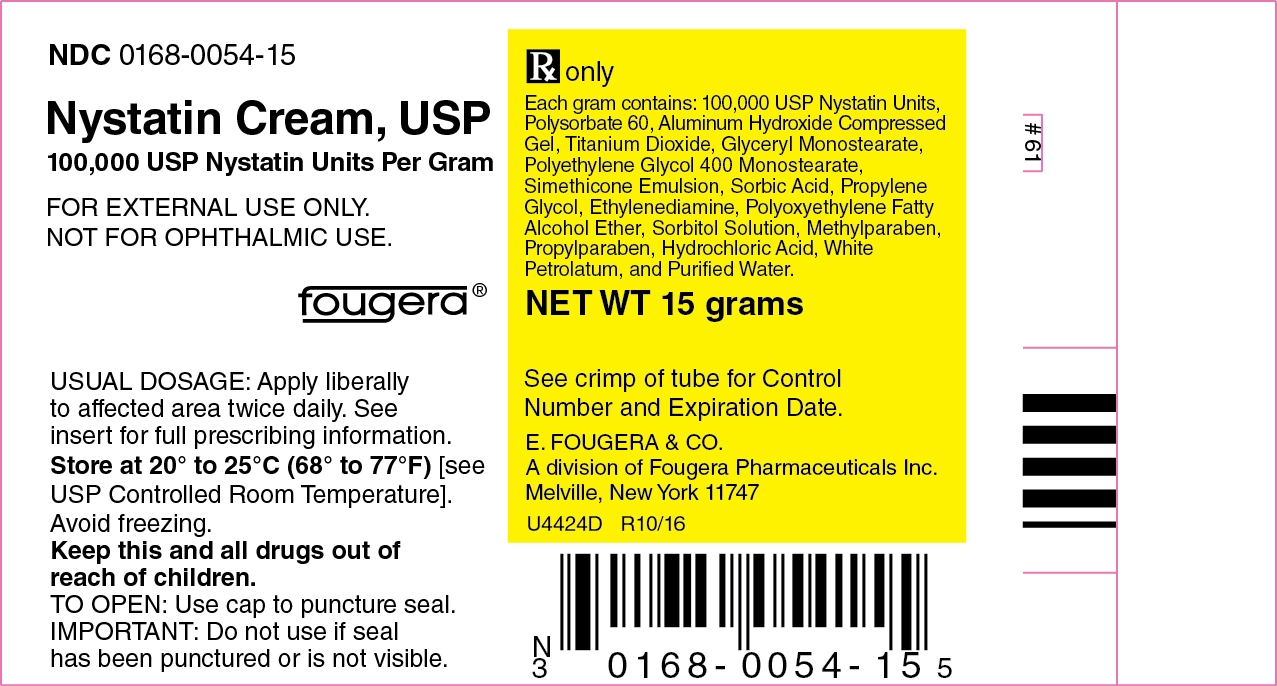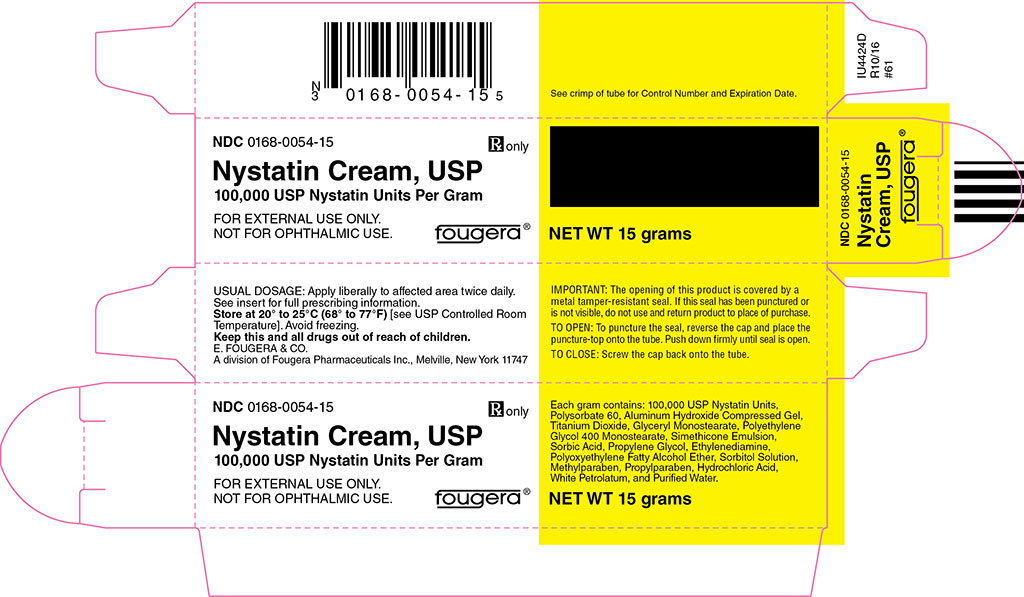nystatin by E. Fougera & Co. a division of Fougera Pharmaceuticals Inc. / MIDI Labs, Inc NYSTATIN cream
nystatin by
Drug Labeling and Warnings
nystatin by is a Prescription medication manufactured, distributed, or labeled by E. Fougera & Co. a division of Fougera Pharmaceuticals Inc., MIDI Labs, Inc. Drug facts, warnings, and ingredients follow.
Drug Details [pdf]
- SPL UNCLASSIFIED SECTION
-
DESCRIPTION:
Nystatin is a polyene antifungal antibiotic obtained from Streptomyces nursei. Structural formula:
Molecular Weight 926.13
Molecular Formula C47H75NO17
Nystatin cream is for dermatologic use.
Nystatin cream for topical use, contains 100,000 USP nystatin units per gram in an aqueous, vanishing cream base containing Polysorbate 60, Aluminum Hydroxide Compressed Gel, Titanium Dioxide, Glyceryl Monostearate, Polyethylene Glycol 400 Monostearate, Simethicone Emulsion, Sorbic Acid, Propylene Glycol, Ethylenediamine, Polyoxyethylene Fatty Alcohol Ether, Sorbitol Solution, Methylparaben, Propylparaben, Hydrochloric Acid, White Petrolatum, and Purified Water.
-
CLINICAL PHARMACOLOGY:
Pharmacokinetics: Nystatin is not absorbed from intact skin or mucous membrane.
Microbiology: Nystatin is an antifungal antibiotic which is both fungistatic and fungicidal in vitro against a wide variety of yeasts and yeast-like fungi, including Candida albicans, C. parapsilosis, C. tropicalis, C. guilliermondi, C. pseudotropicalis, C. krusei, Torulopsis glabrata, Tricophyton rubrum, T. mentagrophytes. Nystatin acts by binding to sterols in the cell membrane of susceptible species resulting in a change in membrane permeability and the subsequent leakage of intracellular components. On repeated subculturing with increasing levels of nystatin, Candida albicans does not develop resistance to nystatin. Generally, resistance to nystatin does not develop during therapy. However, other species of Candida (C. tropicalis, C. guilliermondi, C. krusei, and C. stellatoides) become quite resistant on treatment with nystatin and simultaneously become cross resistant to amphotericin as well. This resistance is lost when the antibiotic is removed. Nystatin exhibits no appreciable activity against bacteria, protozoa, or viruses.
- INDICATIONS AND USAGE:
- CONTRAINDICATIONS:
-
PRECAUTIONS:
General: Nystatin cream should not be used for the treatment of systemic, oral, intravaginal or ophthalmic infections.
If irritation or sensitization develops, treatment should be discontinued and appropriate measures taken as indicated. It is recommended that KOH smears, cultures, or other diagnostic methods be used to confirm the diagnosis of cutaneous or mucocutaneous candidiasis and to rule out infection caused by other pathogens.
INFORMATION FOR THE PATIENT: Patients using this medication should receive the following information and instructions:
1. The patient should be instructed to use this medication as directed (including the replacement of missed doses). This medication is not for any disorder other than that for which it is prescribed.
2. Even if symptomatic relief occurs within the first few days of treatment, the patient should be advised not to interrupt or discontinue therapy until the prescribed course of treatment is completed.
3. If symptoms of irritation develop, the patient should be advised to notify the physician promptly.
Laboratory Tests: If there is a lack of therapeutic response, KOH smears, cultures, or other diagnostic methods should be repeated.
Carcinogenesis, Mutagenesis, Impairment of Fertility: No long-term animal studies have been performed to evaluate the carcinogenic potential of nystatin. No studies have been performed to determine the mutagenicity of nystatin or the effects on male or female fertility.
Pregnancy: Teratogenic Effects: Category C: Animal reproduction studies have not been conducted with any nystatin cream. It also is not known whether this cream can cause fetal harm when used by a pregnant woman or can affect reproductive capacity. Nystatin cream should be prescribed for a pregnant woman only if the potential benefit to the mother outweighs the potential risk to the fetus.
Nursing Mothers: It is not known whether nystatin is excreted in human milk. Caution should be exercised when nystatin is prescribed for a nursing woman.
Pediatric Use: Safety and effectiveness have been established in the pediatric population from birth to 16 years. (See DOSAGE AND ADMINISTRATION.)
Geriatric Use: Clinical studies with nystatin cream did not include sufficient numbers of subjects aged 65 years and older to determine whether they respond differently than younger subjects. Other reported clinical experience has not identified differences in responses between elderly and younger patients, but greater sensitivity of some older individuals cannot be ruled out.]
-
ADVERSE REACTIONS:
The frequency of adverse events reported in patients using nystatin cream is less than 0.1%. The more common events that were reported include allergic reactions, burning, itching, rash, eczema, and pain on application. (See PRECAUTIONS: General.)
- DOSAGE AND ADMINISTRATION:
-
HOW SUPPLIED:
Nystatin Cream USP is available as follows:
NDC: 0168-0054-15 15 gram tube
NDC: 0168-0054-30 30 gram tubeEach tube provides 100,000 USP Nystatin Units per gram.
Store at 20°-25°C (68°-77°F) [see USP Controlled Room Temperature].
Avoid freezing.
E. FOUGERA & CO.
A division of
Fougera
PHARMACEUTICALS INC.
Melville, New York 11747I25415G
R07/13
#61 - PACKAGE LABEL – PRINCIPAL DISPLAY PANEL – 15G CONTAINER
- PACKAGE LABEL – PRINCIPAL DISPLAY PANEL – 15 G CARTON
-
INGREDIENTS AND APPEARANCE
NYSTATIN
nystatin creamProduct Information Product Type HUMAN PRESCRIPTION DRUG Item Code (Source) NDC: 0168-0054 Route of Administration TOPICAL Active Ingredient/Active Moiety Ingredient Name Basis of Strength Strength nystatin (UNII: BDF1O1C72E) (nystatin - UNII:BDF1O1C72E) nystatin 100000 [USP'U] in 1 g Inactive Ingredients Ingredient Name Strength Polysorbate 60 (UNII: CAL22UVI4M) Algeldrate (UNII: 03J11K103C) Titanium Dioxide (UNII: 15FIX9V2JP) Glyceryl Monostearate (UNII: 230OU9XXE4) PEG-8 Stearate (UNII: 2P9L47VI5E) Silicon Dioxide (UNII: ETJ7Z6XBU4) Sorbic Acid (UNII: X045WJ989B) Propylene Glycol (UNII: 6DC9Q167V3) Ethylenediamine (UNII: 60V9STC53F) Sorbitol (UNII: 506T60A25R) Methylparaben (UNII: A2I8C7HI9T) Propylparaben (UNII: Z8IX2SC1OH) Hydrochloric Acid (UNII: QTT17582CB) Petrolatum (UNII: 4T6H12BN9U) Water (UNII: 059QF0KO0R) Packaging # Item Code Package Description Marketing Start Date Marketing End Date 1 NDC: 0168-0054-15 1 in 1 CARTON 02/01/1979 1 15 g in 1 TUBE; Type 0: Not a Combination Product 2 NDC: 0168-0054-30 1 in 1 CARTON 02/01/1979 2 30 g in 1 TUBE; Type 0: Not a Combination Product Marketing Information Marketing Category Application Number or Monograph Citation Marketing Start Date Marketing End Date ANDA ANDA062129 02/01/1979 Labeler - E. Fougera & Co. a division of Fougera Pharmaceuticals Inc. (043838424) Establishment Name Address ID/FEI Business Operations MIDI Labs, Inc 011372047 ANALYSIS(0168-0054)
© 2025 FDA.report
This site is not affiliated with or endorsed by the FDA.


